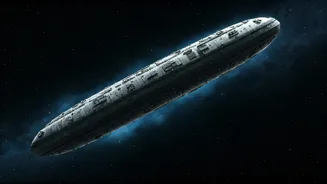Telescope's Cosmic Vision
The James Webb Space Telescope (JWST) has once again demonstrated its unparalleled ability to observe the universe. This time, it has pinpointed a massive
scar within a distant galaxy, which is approximately 20,000 light-years in length, likely caused by a supermassive black hole. JWST, with its advanced infrared capabilities, allows astronomers to peer through cosmic dust and observe celestial bodies and phenomena that are otherwise hidden from view. This allows for detailed analysis that provides insights into the dynamics of galactic systems. This discovery underscores the crucial role that telescopes play in advancing our comprehension of the cosmos and the events that shape galaxies over vast timescales.
Black Hole's Influence
The recent JWST observation centers on the impact of a supermassive black hole, which is found at the heart of many galaxies. These black holes possess enormous gravitational pull, capable of consuming matter and influencing their environment in various ways. The scar detected provides direct evidence of this influence. As matter, such as gas and dust, falls towards a black hole, it forms an accretion disk, often radiating energy that can blast material outward in powerful jets. These jets are thought to be the cause of the scar found in the distant galaxy. This phenomenon highlights the dramatic role black holes play in the evolution and structure of galaxies, and this particular observation allows for a more profound comprehension of these events.
The Galaxy's Transformation
The elongated scar observed within the galaxy suggests a major event that has significantly altered its structure. The length of 20,000 light-years suggests the effect of the black hole's impact on its surroundings on a grand scale. This implies the black hole has possibly disrupted the galaxy's star formation processes, as well as possibly reshaping its overall structure. Understanding how black holes affect galaxies is crucial for a complete picture of the universe's evolution. Observing events like this provides vital information on the interplay between galaxies and supermassive black holes, offering clues on the development of galaxies over cosmic time, and how they change.
JWST's Future Prospects
The discovery is the latest in a series of findings made possible by the James Webb Space Telescope. The telescope's advanced technology will keep playing a key role in future research, allowing astronomers to examine the universe in greater detail. JWST's ongoing observations promise to deliver further insights into cosmic events, galaxies, and other celestial objects. Scientists are eagerly anticipating the data that will result from continued use of the telescope. These advanced observations will keep deepening our understanding of the universe. With each discovery, the James Webb Space Telescope is expanding the boundaries of scientific knowledge and inspiring the exploration of the unknown.







